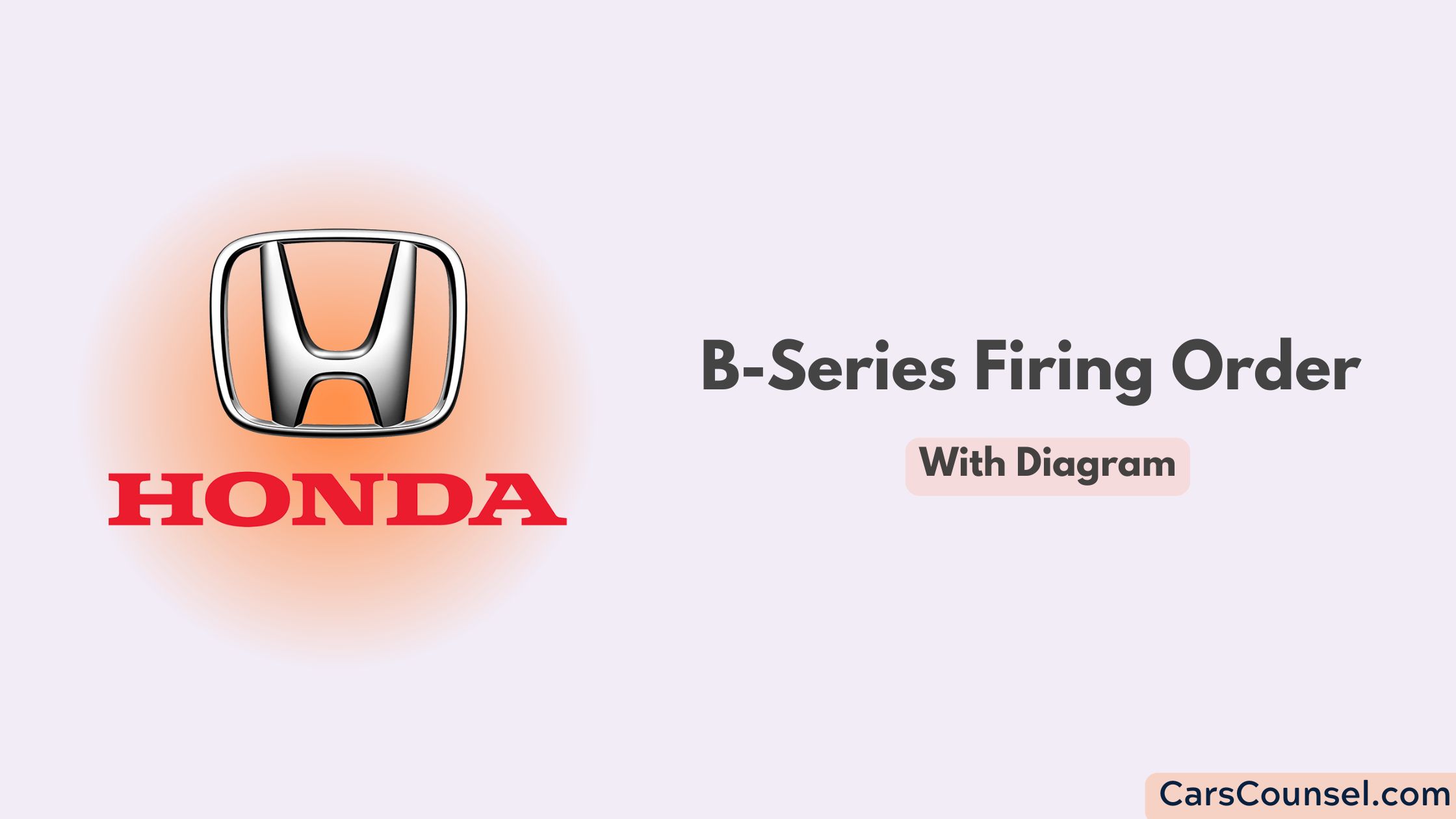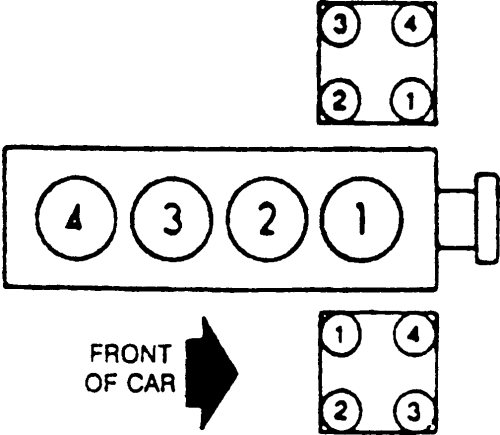The Honda B-Series engines, iconic in the automotive and tuning community, are known for their reliability, performance, and high-revving capabilities. Understanding the firing order of these engines is essential for maintenance, troubleshooting, and optimizing performance. This guide focuses on critical information in a concise, conversational format.

Quick Navigation
B-Series Firing Order
The firing order for Honda B-Series engines is: 1-3-4-2

This sequence repeats as the engine cycles, ensuring consistent power and stability.
What is the Firing Order?
The firing order is the sequence in which the engine’s cylinders fire. In the Honda B-Series, the firing order ensures smooth operation, balanced power delivery, and efficient combustion.
Why the Firing Order Matters
- Engine Smoothness: The correct firing order minimizes vibrations and ensures smooth operation.
- Power Delivery: Balanced firing distributes power evenly across all cylinders.
- Fuel Efficiency: Proper sequencing optimizes combustion and reduces energy waste.
- Troubleshooting Aid: Knowing the firing order simplifies diagnosing misfires and timing issues.
Engine Layout and Cylinder Numbering
The Honda B-Series engines are inline-four engines with all cylinders arranged in a single row. Understanding their layout and numbering is crucial for diagnostics and maintenance.
Cylinder Numbering
- Cylinder 1: Closest to the timing belt.
- Cylinder 2: Second from the timing belt.
- Cylinder 3: Third from the timing belt.
- Cylinder 4: Farthest from the timing belt.
This sequential numbering system is used across all B-Series engines.
Components Involved in the Firing Order
Several components work together to execute the firing order in B-Series engines:
- Crankshaft: Coordinates piston movement and determines cylinder timing.
- Camshaft: Controls valve timing to align with the firing sequence.
- Distributor or Ignition System: Routes sparks to the correct spark plug.
- Spark Plugs: Ignite the air-fuel mixture in each cylinder.
- ECU (Engine Control Unit): Manages ignition timing and fuel injection.
Each component must function perfectly to maintain the firing order.
How the Firing Order Works
The Honda B-Series operates on a four-stroke cycle:
- Intake Stroke: The piston moves down, drawing in air and fuel.
- Compression Stroke: The piston moves up, compressing the mixture.
- Power Stroke: The spark plug ignites the mixture, driving the piston down.
- Exhaust Stroke: The piston moves up, expelling exhaust gases.
The firing order determines the sequence of power strokes across all four cylinders, ensuring continuous operation.
Common Problems with Firing Order
Misfires: Disrupted firing order causes incomplete combustion.
- Symptoms: Rough idle, loss of power, increased emissions.
- Causes: Worn spark plugs, faulty ignition wires, or distributor issues.
Vibrations: An incorrect firing order creates engine imbalance.
- Diagnosis: Check spark plug connections and distributor alignment.
Engine Knock: Improper timing results in pre-ignition or detonation.
- Prevention: Use high-octane fuel and ensure proper timing settings.
Power Loss: Incorrect firing disrupts combustion efficiency.
- Solution: Inspect ignition and timing components for alignment.
How to Check the Firing Order
- Consult the Manual: Refer to the vehicle’s repair manual for specific details.
- Inspect the Distributor: Ensure wires connect to the correct cylinders.
- Check Timing: Use a timing light to verify proper ignition timing.
- Perform a Compression Test: Confirm even compression across cylinders.
- Use Diagnostic Tools: Check for error codes with an OBD-II scanner.
Adjusting the Firing Order
The firing order in the Honda B-Series is fixed by the engine’s design and cannot be changed without extensive modifications. However, proper maintenance ensures the firing order functions correctly:
- Verify Distributor Orientation: Check that the rotor aligns with the correct cylinder when firing.
- Inspect Spark Plug Wires: Ensure proper routing to match the firing sequence.
- Replace Worn Components: Address issues with spark plugs, ignition wires, or distributor caps.
- Maintain Timing Belts: Ensure the camshaft and crankshaft remain synchronized.
Troubleshooting Firing Order Issues
- Inspect Spark Plugs: Look for fouling, wear, or incorrect gaps.
- Test Ignition Wires: Verify correct routing and continuity.
- Check the Distributor: Inspect for cracks, carbon tracking, or misalignment.
- Inspect Timing Components: Ensure the timing belt or chain is properly aligned.
- Use Compression Tests: Confirm consistent pressure across all cylinders.
Maintenance Tips for Optimal Firing Order
- Replace Spark Plugs Regularly: Follow manufacturer-recommended intervals.
- Inspect Ignition Wires: Replace damaged or worn wires.
- Maintain the Distributor: Clean or replace the cap and rotor as needed.
- Service the Timing Belt: Replace it if stretched or worn to prevent misalignment.
- Use High-Quality Fuel: Prevent deposits in the combustion chamber.
Performance Considerations
The Honda B-Series is a favorite for enthusiasts who demand performance. Keeping the firing order intact is essential for reliable operation:
- Tuning: Retain the factory firing order for stability and balance during tuning.
- Upgraded Ignition Systems: High-performance ignition components enhance spark delivery and efficiency.
- Compression Testing: Ensure even compression across cylinders for optimal power output.
- Exhaust System Design: Match the system to the firing order for better sound and flow.
Summary of Key Points
- Firing Order: 1-3-4-2.
- Cylinder Layout: Cylinders are numbered sequentially from the timing belt side.
- Critical Components: Crankshaft, camshaft, distributor, spark plugs, ECU.
- Common Issues: Misfires, vibrations, power loss, and engine knock.
- Maintenance Essentials: Replace spark plugs, inspect ignition systems, and maintain timing belts.
Engines with Similar Firing Orders
- 2010 Honda Odyssey Firing Order
- 2004 Honda Civic Firing Order
- 2001 Honda Civic Firing Order
- 2002 Honda Civic Firing Order
- 2002 Honda Accord Firing Order
Final Thoughts
The B-Series firing order (1-3-4-2) is a foundational aspect of its performance and reliability. Understanding and maintaining the firing sequence ensures smooth operation, efficient combustion, and consistent power delivery. Whether you’re performing routine maintenance or advanced tuning, respecting the firing order is critical for the engine’s health and performance. By focusing on ignition timing and component health, you can unlock the full potential of your Honda B-Series engine.

